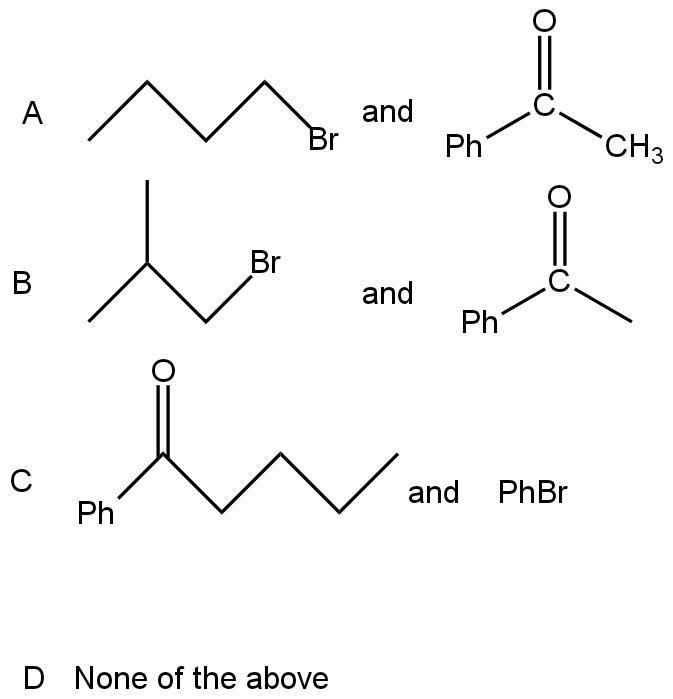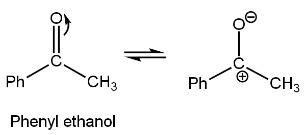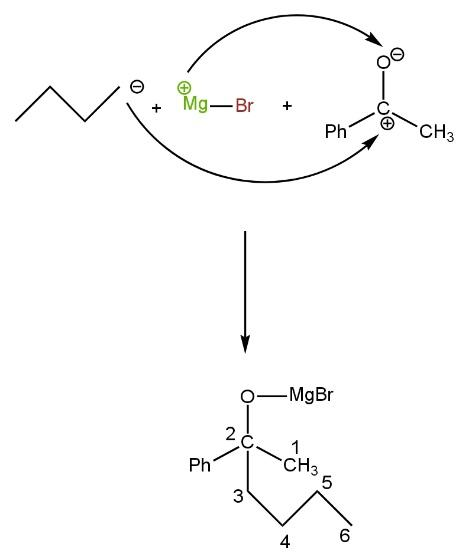
\[2-phenyl-2-hexanol\] can be prepared by Grignard synthesis. The pair of compounds giving the desired product is

Answer
222.9k+ views
Hint: Grignard synthesis is the reaction in which organomagnesium halide (RMgX, Grignard reagent) is added to a ketone or to an aldehyde (carbonyl group-containing compound) to generate secondary or tertiary alcohol. In this question, we need to prepare \[2-phenyl-2-hexanol\], which is a chain of six carbons with one phenyl and one hydroxyl group.
Complete Step by Step Solution:
In option A, ketone compound is given (carbonyl compound), phenyl ethanon. As it is a ketonic group thus, the Grignard reagent will attack it which is\[{{C}_{4}}{{H}_{9}}MgBr\](RMgX). Oxygen group of carbonyl group in Phenyl ethanon attract one bond out of double bond due to high electronegativity of oxygen as compared to electronegativity of carbon to which it is bonded toward itself and attain negative charge such as

Now, the positive part of the Grignard reagent attacks the negative part of phenyl ethanone, and the negative part of the Grignard reagent attack the positive part of phenyl ethanone. Grignard reagent (\[{{C}_{4}}{{H}_{9}}MgBr\]), alkyl group,\[{{C}_{4}}{{H}_{9}}\]negatively charged while MgBr is positively charged such as

Now, this resulting compound undergoes hydrolysis (addition of water molecule). Due to this MgBr (positively charged) form bond with OH (negatively charged) and oxygen (negatively charged) form bond with H (positively charged, proton) giving three-degree alcohol, namely \[2-phenyl-2-hexanol\] such as

Hence we got 2-phenyl-2-hexanol from compounds of A. Thus, the correct option is A.
Note: Compounds Band D cannot form \[2-phenyl-2-hexanol\] because they do not form the resulting chain of six carbon. As discussed above, we can see that the number of ketonic group carbon (2) and Grignard reagent carbon (6) just added up. In compound B, the Grignard reagent has 3 carbon (1 is an alkyl group and not included in the main chain), and the other compound (Acetophenone) has one carbon or can be two carbon but still, it is less than 6 carbon for the main chain. While compound C has more than 6 carbon in the main chain because the Grignard reagent has 6 carbon (Ph group) and the ketonic compound has 6 carbon. Thus, the total number of carbon is more than 6.
Complete Step by Step Solution:
In option A, ketone compound is given (carbonyl compound), phenyl ethanon. As it is a ketonic group thus, the Grignard reagent will attack it which is\[{{C}_{4}}{{H}_{9}}MgBr\](RMgX). Oxygen group of carbonyl group in Phenyl ethanon attract one bond out of double bond due to high electronegativity of oxygen as compared to electronegativity of carbon to which it is bonded toward itself and attain negative charge such as

Now, the positive part of the Grignard reagent attacks the negative part of phenyl ethanone, and the negative part of the Grignard reagent attack the positive part of phenyl ethanone. Grignard reagent (\[{{C}_{4}}{{H}_{9}}MgBr\]), alkyl group,\[{{C}_{4}}{{H}_{9}}\]negatively charged while MgBr is positively charged such as

Now, this resulting compound undergoes hydrolysis (addition of water molecule). Due to this MgBr (positively charged) form bond with OH (negatively charged) and oxygen (negatively charged) form bond with H (positively charged, proton) giving three-degree alcohol, namely \[2-phenyl-2-hexanol\] such as

Hence we got 2-phenyl-2-hexanol from compounds of A. Thus, the correct option is A.
Note: Compounds Band D cannot form \[2-phenyl-2-hexanol\] because they do not form the resulting chain of six carbon. As discussed above, we can see that the number of ketonic group carbon (2) and Grignard reagent carbon (6) just added up. In compound B, the Grignard reagent has 3 carbon (1 is an alkyl group and not included in the main chain), and the other compound (Acetophenone) has one carbon or can be two carbon but still, it is less than 6 carbon for the main chain. While compound C has more than 6 carbon in the main chain because the Grignard reagent has 6 carbon (Ph group) and the ketonic compound has 6 carbon. Thus, the total number of carbon is more than 6.
Recently Updated Pages
JEE General Topics in Chemistry Important Concepts and Tips

JEE Extractive Metallurgy Important Concepts and Tips for Exam Preparation

JEE Atomic Structure and Chemical Bonding important Concepts and Tips

JEE Amino Acids and Peptides Important Concepts and Tips for Exam Preparation

Electricity and Magnetism Explained: Key Concepts & Applications

JEE Energetics Important Concepts and Tips for Exam Preparation

Trending doubts
JEE Main 2026: Application Form Open, Exam Dates, Syllabus, Eligibility & Question Papers

Derivation of Equation of Trajectory Explained for Students

Hybridisation in Chemistry – Concept, Types & Applications

Understanding the Angle of Deviation in a Prism

How to Convert a Galvanometer into an Ammeter or Voltmeter

Degree of Dissociation: Meaning, Formula, Calculation & Uses

Other Pages
Solutions Class 12 Chemistry Chapter 1 CBSE Notes - 2025-26

NCERT Solutions For Class 12 Chemistry Chapter 1 Solutions - 2025-26

The D and F Block Elements Class 12 Chemistry Chapter 4 CBSE Notes - 2025-26

NCERT Solutions for Class 12 Chemistry Chapter Chapter 7 Alcohol Phenol and Ether

NCERT Solutions ForClass 12 Chemistry Chapter Chapter 8 Aldehydes Ketones And Carboxylic Acids

JEE Advanced Marks vs Ranks 2025: Understanding Category-wise Qualifying Marks and Previous Year Cut-offs




